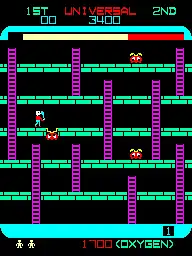Space Panic
Space Panic (スぺース・パ二ック, Supesu Panikku) is a 1980 arcade game designed by Universal. Predating Nintendo's Donkey Kong, and lacking a jump mechanic, Space Panic was the first game involving climbing ladders between walkable platforms. The genre was initially labeled as "climbing games," but later became known as platform games.[1][2] A ColecoVision port by CBS Electronics was released in 1983.
| Space Panic | |
|---|---|
| Developer(s) | Universal CBS Electronics (CV) |
| Publisher(s) | Universal Coleco (CV) |
| Platform(s) | Arcade, ColecoVision, PV-1000 |
| Release | November 1980: Arcade 1981: PV-1000 1983: ColecoVision |
| Genre(s) | Platform |
| Mode(s) | Single-player, 2 players alternating |
Gameplay

The main character can move along platforms and climb the ladders between them. The goal is to dig holes in the platforms and lure aliens into them. Hitting a trapped alien with the shovel knocks them out of the hole and off the screen. In later levels, two or more holes must be lined up vertically in order to dispose of stronger aliens.
There is a limited supply of oxygen, which acts as a timer.
Reception
Space Panic was commercially unsuccessful, which Electronic Games in 1983 attributed to its concepts' novelty to the audience: "not only the first of the climbing games, it was also the first of the digging games. That's quite a load for a player on a new game. No punning intended when I say that the rungs were too high for the average gamer to scale." The magazine reported that the average play time was 30 seconds.[3]
In a retrospective review of the ColecoVision version for Digital Press Online, Kevin Oleniacz concluded, "Coleco had resurrected several short-lived arcade games and transformed them into home favorites, but they should have let Space Panic rest in peace."[4]
Legacy
The concept found success in the unauthorized home computer version, Apple Panic, and in 1983's Lode Runner which has a similar look and also uses the basic premise of digging holes to trap enemies.
Universal revisited the genre with Mr. Do's Castle (1983), which expanded upon the play styles explored in Space Panic.
Clones
| First Published | Name | Company | System(s) |
|---|---|---|---|
| 1981 | Apple Panic | Broderbund | Apple II, Atari 8-bit, IBM PC, TRS-80, VIC-20 |
| 1982 | Panic | Visions Software Factory | ZX Spectrum |
| 1982 | Monsters | Acornsoft | Acorn Electron, BBC Micro |
| 1983 | Monsters in Hell | Softek Software | ZX Spectrum |
| 1983 | Bonka | J. Morrison (Micros) Ltd. | Dragon 32/64, C64 |
| 1983 | Color Panic [5] | Spectral Associates | TRS-80 Color Computer |
| 1983 | Cuthbert Goes Digging | Microdeal | TRS-80 Color Computer, Dragon 32 |
| 1983 | Panic 64 | Interceptor Micros | C64 |
| 1983 | Sam Spade | Silversoft Ltd | ZX Spectrum |
| 1984 | Panic Planet | Alligata | C64 |
| 1984 | Monsters 64 | C64 | |
| 1984 | Hektik | Mastertronic | C64, VIC-20, Commodore C16 |
| 1984 | Roland Goes Digging | Amsoft/Gem Software | Amstrad CPC |
| 1984 | Psychiatric | Sprites Software | Oric 1, Oric Atmos |
| 1986 | Panik! | Atlantis | Commodore 16, BBC Micro, Acorn Electron, Atari 8-bit |
References
- Bloom, Steve (1982). Video Invaders. Arco Publishing. p. 29. ISBN 978-0668055208.
- Crawford, Chris (2003). Chris Crawford on Game Design. New Riders. ISBN 0-88134-117-7.
- Pearl, Rick (June 1983). "Closet Classics". Electronic Games. p. 82. Retrieved 6 January 2015.
- Oleniacz, Kevin (December 2003). "Space Panic". Digital Press Online.
- Boyle, L. Curtis. "Color Panic". Tandy (TRS-80) Color Computer Games.